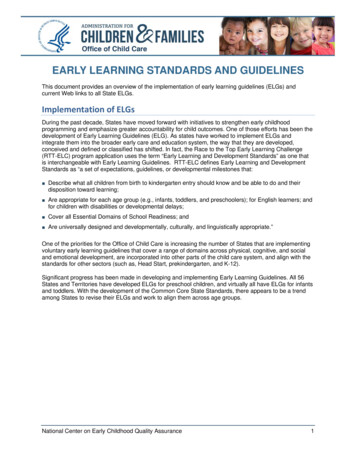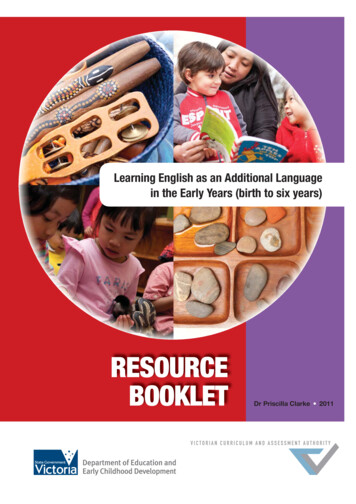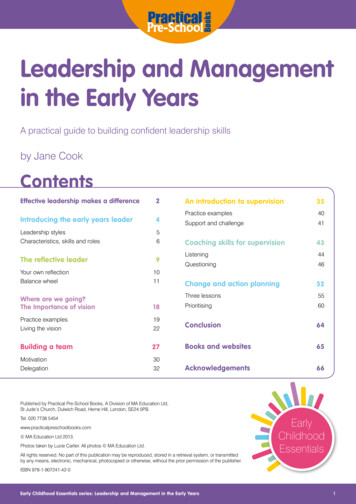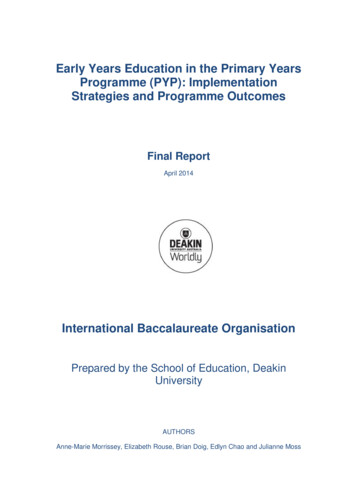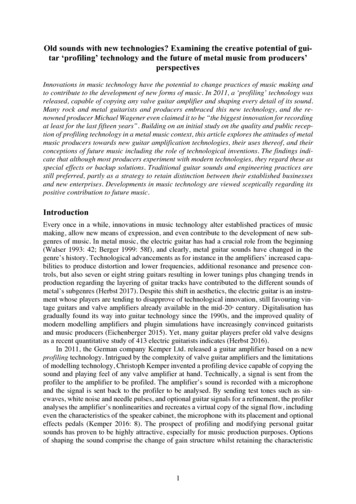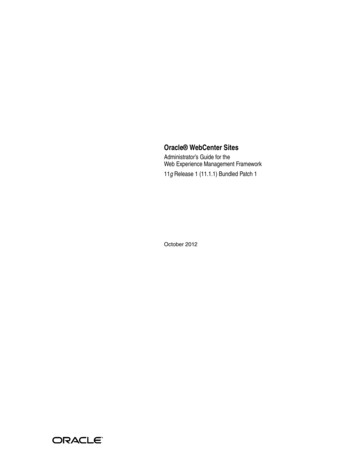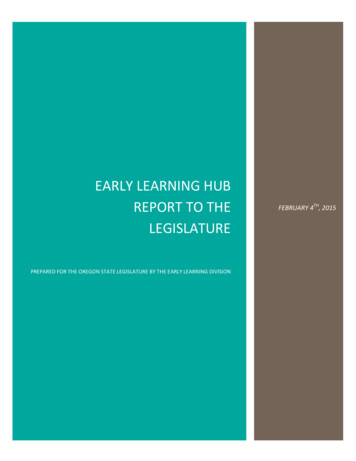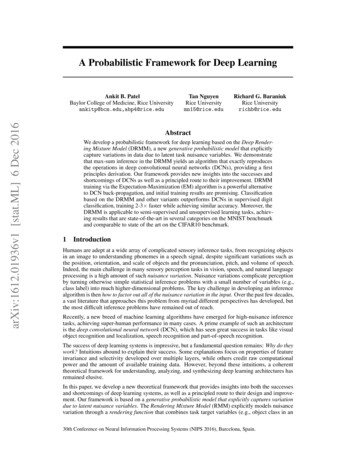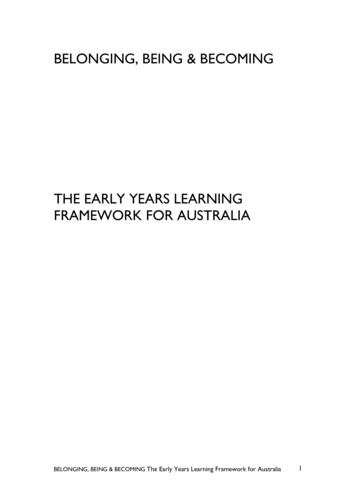
Transcription
BELONGING, BEING & BECOMINGTHE EARLY YEARS LEARNINGFRAMEWORK FOR AUSTRALIABELONGING, BEING & BECOMING The Early Years Learning Framework for Australia1
ISBN 978-642-77872-7With the exception of the Commonwealth Coat of Arms, the Department’s logo, anymaterial protected by a trade mark and where otherwise noted all material presented inthis document is provided under a Creative Commons Attribution 4.0 by/3.0/au/) licence.The details of the relevant licence conditions are available on the Creative Commonswebsite (accessible using the links provided) as is the full legal code for the CC BY4.0 International ode).The document must be attributed as the (The Early Years learning Framework forAustralia).Reproduced by the Australian Government Department of Education and Training. for the Council ofAustralian Governments.BELONGING, BEING & BECOMING The Early Years Learning Framework for Australia2
CONTENTSINTRODUCTION5A VISION FOR CHILDREN’S LEARNINGElements of the FrameworkChildren’s Learning7910EARLY CHILDHOOD PEDAGOGY12PRINCIPLES13PRACTICE16LEARNING OUTCOMES FOR CHILDREN BIRTH TO 5 YEARSOutcome 1: Children have a strong sense of identity2223Children feel safe, secure, and supportedChildren develop their emerging autonomy, inter-dependence, resilienceand sense of agencyChildren develop knowledgeable and confident self identitiesChildren learn to interact in relation to others with care, empathy and respectOutcome 2: Children are connected with and contribute to their world2425262728Children develop a sense of belonging to groups and communities andan understanding of the reciprocal rights and responsibilities necessaryfor active community participationChildren respond to diversity with respectChildren become aware of fairnessChildren become socially responsible and show respect for the environmentOutcome 3: Children have a strong sense of wellbeing2930313233Children become strong in their social and emotional wellbeingChildren take increasing responsibility for their own health and physical wellbeingOutcome 4: Children are confident and involved learners343536Children develop dispositions for learning such as curiosity, cooperation,confidence, creativity, commitment, enthusiasm, persistence, imaginationand reflexivityChildren develop a range of skills and processes such as problem solving,inquiry, experimentation, hypothesising, researching and investigatingChildren transfer and adapt what they have learned from one context to anotherChildren resource their own learning through connecting with people, place,technologies and natural and processed materialsOutcome 5: Children are effective communicators3738394041Children interact verbally and non-verbally with others for a range of purposesChildren engage with a range of texts and gain meaning from these textsChildren express ideas and make meaning using a range of mediaChildren begin to understand how symbols and pattern systems workChildren use information and communication technologies to access information,investigate ideas and represent their thinkingBELONGING, BEING & BECOMING The Early Years Learning Framework for Australia43444546473
GLOSSARY OF TERMS48BIBLIOGRAPHY50BELONGING, BEING & BECOMING The Early Years Learning Framework for Australia4
INTRODUCTIONThis is Australia’s first national Early Years Learning Framework for early childhood educators. Theaim of this document is to extend and enrich children’s learning from birth to five years and throughthe transition to school.The Council of Australian Governments has developed this Framework to assist educators to provideyoung children with opportunities to maximise their potential and develop a foundation for futuresuccess in learning. In this way, the Early Years Learning Framework (the Framework) will contributeto realising the Council of Australian Governments’ vision that:“All children have the best start in life to create a better future for themselves and for the nation.”1The Framework draws on conclusive international evidence that early childhood is a vital period inchildren’s learning and development. It has been developed with considerable input from the earlychildhood sector, early childhood academics and the Australian and State and Territory Governments.The Framework forms the foundation for ensuring that children in all early childhood education andcare settings experience quality teaching and learning. It has a specific emphasis on play-based learningand recognises the importance of communication and language (including early literacy and numeracy)and social and emotional development. The Framework has been designed for use by early childhoodeducators working in partnership with families, children’s first and most influential educators.Early childhood educators guided by the Framework will reinforce in their daily practice the principleslaid out in the United Nations Convention on the Rights of the Child (the Convention). TheConvention states that all children have the right to an education that lays a foundation for the rest oftheir lives, maximises their ability, and respects their family, cultural and other identities andlanguages. The Convention also recognises children’s right to play and be active participants in allmatters affecting their lives.This document may complement, supplement or replace individual State and Territory frameworks.The exact relationship will be determined by each jurisdiction.More broadly, the Framework supports Goal 2 of the Melbourne Declaration on Education Goals forYoung Australians2, that:All young Australians become: Successful learners Confident and creative individuals Active and informed citizens.The Melbourne Declaration also commits to improved outcomes for Aboriginal and Torres StraitIslander young people and strengthening early childhood education.The Council of Australian Governments is committed to closing the gap in educational achievementbetween Indigenous and non-Indigenous Australians within a decade3. Early childhood education has acritical role to play in delivering this outcome.1 Investing in the Early Years - a National Early Childhood Development Strategy, Council of Australian Governments2 On 5 December 2008, State, Territory and Commonwealth Ministers of Education meeting as the Ministerial Council onEducation, Employment, Training and Youth Affairs, released the Melbourne Declaration on Educational Goals for YoungAustralians.3 The Council of Australian Governments – Communique – 3 July 2008. Indigenous Reform – Closing the Gap.BELONGING, BEING & BECOMING The Early Years Learning Framework for Australia5
Recognising this, a specific document that provides educators with additional guidance on ensuringcultural security for Aboriginal and Torres Strait Islander children and their families will be developedand made available to educators.Over time additional resources may be developed to support the application of this Framework.Children:refers to babies, toddlers and three to five year olds, unless otherwise stated.Educators:early childhood practitioners who work directly with children in early childhood settings.Play-based learning:a context for learning through which children organise and make sense of their social worlds, as theyengage actively with people, objects and representations.BELONGING, BEING & BECOMING The Early Years Learning Framework for Australia6
A VISION FORCHILDREN’S LEARNINGAll children experience learning that is engagingand builds success for life.Fundamental to the Framework is a view of children’s lives as characterised by belonging, being andbecoming. From before birth children are connected to family, community, culture and place. Theirearliest development and learning takes place through these relationships, particularly within families,who are children’s first and most influential educators. As children participate in everyday life, theydevelop interests and construct their own identities and understandings of the world.BELONGINGExperiencing belonging – knowing where and with whom you belong – is integral to human existence.Children belong first to a family, a cultural group, a neighbourhood and a wider community. Belongingacknowledges children’s interdependence with others and the basis of relationships in definingidentities. In early childhood, and throughout life, relationships are crucial to a sense of belonging.Belonging is central to being and becoming in that it shapes who children are and who they can become.“You belong in your house with your family” – DongBEINGChildhood is a time to be, to seek and make meaning of the world.Being recognises the significance of the here and now in children’s lives. It is about the present andthem knowing themselves, building and maintaining relationships with others, engaging with life’s joysand complexities, and meeting challenges in everyday life. The early childhood years are not solelypreparation for the future but also about the present.“If you want to be a mermaid you can imagine” – JazmineBECOMINGChildren’s identities, knowledge, understandings, capacities, skills and relationships change duringchildhood. They are shaped by many different events and circumstances. Becoming reflects thisprocess of rapid and significant change that occurs in the early years as young children learn and grow.It emphasises learning to participate fully and actively in society.BELONGING, BEING & BECOMING The Early Years Learning Framework for Australia7
“When you keep planting plants you become a gardener” – OliviaThe Framework conveys the highest expectations for all children’s learning from birth to five yearsand through the transitions to school. It communicates these expectations through the following fiveLearning Outcomes: Children have a strong sense of identity Children are connected with and contribute to their world Children have a strong sense of wellbeing Children are confident and involved learners Children are effective communicators.The Framework provides broad direction for early childhood educators in early childhood settings tofacilitate children’s learning.It guides educators in their curriculum decision-making and assists in planning, implementing andevaluating quality in early childhood settings. It also underpins the implementation of more specificcurriculum relevant to each local community and early childhood setting.The Framework is designed to inspire conversations, improve communication and provide a commonlanguage about young children’s learning among children themselves, their families, the broadercommunity, early childhood educators and other professionals.Learning outcome:a skill, knowledge or disposition that educators can actively promote in early childhood settings, incollaboration with children and families.Early childhood settings:long day care, occasional care, family day care, Multi-purpose Aboriginal Children’s Services,preschools and kindergartens, playgroups, creches, early intervention settings and similar services.BELONGING, BEING & BECOMING The Early Years Learning Framework for Australia8
ELEMENTS OF THE FRAMEWORKThe Framework puts children’s learning at the core and comprises three inter-related elements:Principles, Practice and Learning Outcomes (see Figure 1). All three elements are fundamental to earlychildhood pedagogy and curriculum decision-making.Curriculum encompasses all the interactions, experiences, routines and events, planned andunplanned, that occur in an environment designed to foster children’s learning and development.The emphasis in the Framework is on the planned or intentional aspects of the curriculum.Children are receptive to a wide range of experiences. What is included or excluded from thecurriculum affects how children learn, develop and understand the world.The Framework supports a model of curriculum decision-making as an ongoing cycle. This involveseducators drawing on their professional knowledge, including their in-depth knowledge of each child.Working in partnership with families, educators use the Learning Outcomes to guide their planning forchildren’s learning. In order to engage children actively in learning, educators identify children’s strengthsand interests, choose appropriate teaching strategies and design the learning environment.Educators carefully assess learning to inform further planning.Curriculum:in the early childhood setting curriculum means ‘all the interactions, experiences, activities, routinesand events, planned and unplanned, that occur in an environment designed to foster children’slearning and development’. [adapted from Te Whariki]Pedagogy:early childhood educators’ professional practice, especially those aspects that involve building andnurturing relationships, curriculum decision-making, teaching and learning.BELONGING, BEING & BECOMING The Early Years Learning Framework for Australia9
CHILDREN’S LEARNINGThe diversity in family life means that children experience belonging, being and becoming in manydifferent ways. They bring their diverse experiences, perspectives, expectations, knowledge and skillsto their learning.Children’s learning is dynamic, complex and holistic. Physical, social, emotional, personal, spiritual,creative, cognitive and linguistic aspects of learning are all intricately interwoven and interrelated.Play is a context for learning that: allows for the expression of personality and uniqueness enhances dispositions such as curiosity and creativity enables children to make connections between prior experiences and new learning assists children to develop relationships and concepts stimulates a sense of wellbeing.Children actively construct their own understandings and contribute to others’ learning. They recognisetheir agency, capacity to initiate and lead learning, and their rights to participate in decisions that affectthem, including their learning.Viewing children as active participants and decision makers opens up possibilities for educators tomove beyond pre-conceived expectations about what children can do and learn. This requireseducators to respect and work with each child’s unique qualities and abilities.Educators’ practices and the relationships they form with children and families have a significant effect onchildren’s involvement and success in learning. Children thrive when families and educators worktogether in partnership to support young children’s learning.Children’s early learning influences their life chances. Wellbeing and a strong sense of connection,optimism and engagement enable children to develop a positive attitude to learning.The Learning Outcomes section of the Framework provides examples of evidence of children’slearning and the educator’s role.Involvement:is a state of intense, whole hearted mental activity, characterised by sustained concentration andintrinsic motivation. Highly involved children (and adults) operate at the limit of their capacities,leading to changed ways of responding and understanding leading to deep level learning. (adapted fromLaevers 1994)Dispositions:enduring habits of mind and actions, and tendencies to respond in characteristic ways to situations,for example, maintaining an optimistic outlook, being willing to persevere, approaching newexperiences with confidence. (Carr, 2001)BELONGING, BEING & BECOMING The Early Years Learning Framework for Australia10
ELEMENTS OF THE EARLY YEARS LEARNINGFRAMEWORKThis diagram shows the relationship between learning outcomes, principles and practice whichcentres on children’s learning. The three themes of Belonging, Being and Becoming are containedoverlapping all of these elements.BELONGING, BEING & BECOMING The Early Years Learning Framework for Australia11
EARLY CHILDHOOD PEDAGOGYThe term pedagogy refers to the holistic nature of early childhood educators’ professional practice(especially those aspects that involve building and nurturing relationships), curriculum decision-making,teaching and learning. When educators establish respectful and caring relationships with children andfamilies, they are able to work together to construct curriculum and learning experiences relevant tochildren in their local context. These experiences gradually expand children’s knowledge andunderstanding of the world.Educators’ professional judgements are central to their active role in facilitating children’s learning. Inmaking professional judgements, they weave together their: professional knowledge and skills knowledge of children, families and communities awareness of how their beliefs and values impact on children’s learning personal styles and past experiences.They also draw on their creativity, intuition and imagination to help them improvise and adjust theirpractice to suit the time, place and context of learning.Different theories about early childhood inform approaches to children’s learning and development.Early childhood educators draw upon a range of perspectives in their work which may include: developmental theories that focus on describing and understanding the processes of changein children’s learning and development over time socio-cultural theories that emphasise the central role that families and cultural groups playin children’s learning and the importance of respectful relationships and provide insight intosocial and cultural contexts of learning and development socio-behaviourist theories that focus on the role of experiences in shaping children’sbehaviour critical theories that invite early childhood educators to challenge assumptions aboutcurriculum, and consider how their decisions may affect children differently post-structuralist theories that offer insights into issues of power, equity and social justice inearly childhood settings.Drawing on a range of perspectives and theories can challenge traditional ways of seeing children,teaching and learning, and encourage educators, as individuals and with colleagues, to: investigate why they act in the ways that they do discuss and debate theories to identify strengths and limitations recognise how the theories and beliefs that they use to make sense of their work enable butalso limit their actions and thoughts consider the consequences of their actions for children’s experiences find new ways of working fairly and justly.BELONGING, BEING & BECOMING The Early Years Learning Framework for Australia12
PRINCIPLESThe following are five Principles that reflect contemporary theories and research evidence concerningchildren’s learning and early childhood pedagogy. The Principles underpin practice that is focused onassisting all children to make progress in relation to the Learning Outcomes.1. SECURE, RESPECTFUL AND RECIPROCAL RELATIONSHIPSEducators who are attuned to children’s thoughts and feelings, support the development of a strongsense of wellbeing. They positively interact with the young child in their learning.Research has shown that babies are both vulnerable and competent. Babies’ first attachments withintheir families and within other trusting relationships provide them with a secure base for explorationand learning.Through a widening network of secure relationships, children develop confidence and feel respectedand valued. They become increasingly able to recognise and respect the feelings of others and tointeract positively with them.Educators who give priority to nurturing relationships and providing children with consistentemotional support can assist children to develop the skills and understandings they need to interactpositively with others. They also help children to learn about their responsibilities to others, toappreciate their connectedness and interdependence as learners, and to value collaboration andteamwork.2. PARTNERSHIPSLearning outcomes are most likely to be achieved when early childhood educators work inpartnership with families. Educators recognise that families are children’s first and most influentialteachers. They create a welcoming environment where all children and families are respected andactively encouraged to collaborate with educators about curriculum decisions in order to ensure thatlearning experiences are meaningful.Partnerships are based on the foundations of understanding each other’s expectations and attitudes,and build on the strength of each others’ knowledge.In genuine partnerships, families and early childhood educators: value each other’s knowledge of each child value each other’s contributions to and roles in each child’s life trust each other communicate freely and respectfully with each other share insights and perspectives about each child engage in shared decision-making.Partnerships also involve educators, families and support professionals working together to explorethe learning potential in every day events, routines and play so that children with additional needs areprovided with daily opportunities to learn from active participation and engagement in theseexperiences in the home and in early childhood or specialist settings.3. HIGH EXPECTATIONS AND EQUITYEarly childhood educators who are committed to equity believe in all children’s capacities to succeed,regardless of diverse circumstances and abilities. Children progress well when they, their parents andeducators hold high expectations for their achievement in learning.BELONGING, BEING & BECOMING The Early Years Learning Framework for Australia13
Educators recognise and respond to barriers to children achieving educational success. In responsethey challenge practices that contribute to inequities and make curriculum decisions that promoteinclusion and participation of all children. By developing their professional knowledge and skills, andworking in partnership with children, families, communities, other services and agencies, theycontinually strive to find equitable and effective ways to ensure that all children have opportunities toachieve learning outcomes.4. RESPECT FOR DIVERSITYThere are many ways of living, being and of knowing. Children are born belonging to a culture, which isnot only influenced by traditional practices, heritage and ancestral knowledge, but also by theexperiences, values and beliefs of individual families and communities. Respecting diversity meanswithin the curriculum valuing and reflecting the practices, values and beliefs of families. Educatorshonour the histories, cultures, languages, traditions, child rearing practices and lifestyle choices offamilies. They value children’s different capacities and abilities and respect differences in families’ homelives.Educators recognise that diversity contributes to the richness of our society and provides a validevidence base about ways of knowing. For Australia it also includes promoting greater understandingof Aboriginal and Torres Strait Islander ways of knowing and being.When early childhood educators respect the diversity of families and communities, and the aspirationsthey hold for children, they are able to foster children’s motivation to learn and reinforce their senseof themselves as competent learners. They make curriculum decisions that uphold all children’s rightsto have their cultures, identities, abilities and strengths acknowledged and valued,and respond to the complexity of children’s and families’ lives.Educators think critically about opportunities and dilemmas that can arise from diversity and take actionto redress unfairness. They provide opportunities to learn about similarities and difference and aboutinterdependence and how we can learn to live together.5. ONGOING LEARNING AND REFLECTIVE PRACTICEEducators continually seek ways to build their professional knowledge and develop learningcommunities. They become co-learners with children, families and community, and value the continuityand richness of local knowledge shared by community members, including Aboriginal and Torres StraitIslander Elders.Reflective practice is a form of ongoing learning that involves engaging with questions of philosophy,ethics and practice. Its intention is to gather information and gain insights that support, inform andenrich decision-making about children’s learning. As professionals, early childhood educators examinewhat happens in their settings and reflect on what they might change.Critical reflection involves closely examining all aspects of events and experiences from differentperspectives. Educators often frame their reflective practice within a set of overarching questions,developing more specific questions for particular areas of enquiry.Overarching questions to guide reflection include: What are my understandings of each child? What theories, philosophies and understandings shape and assist my work? Who is advantaged when I work in this way? Who is disadvantaged? What questions do I have about my work? What am I challenged by? What am I curiousabout? What am I confronted by? What aspects of my work are not helped by the theories and guidance that I usually draw onto make sense of what I do?BELONGING, BEING & BECOMING The Early Years Learning Framework for Australia14
Are there other theories or knowledge that could help me to understand better what I haveobserved or experienced? What are they? How might those theories and that knowledgeaffect my practice?A lively culture of professional inquiry is established when early childhood educators and those withwhom they work are all involved in an ongoing cycle of review through which current practices areexamined, outcomes reviewed and new ideas generated. In such a climate, issues relating to curriculumquality, equity and children’s wellbeing can be raised and debated.BELONGING, BEING & BECOMING The Early Years Learning Framework for Australia15
PRACTICEThe principles of early childhood pedagogy underpin practice. Educators draw on a rich repertoire ofpedagogical practices to promote children’s learning by: adopting holistic approaches being responsive to children planning and implementing learning through play intentional teaching creating physical and social learning environments that have a positive impact on children’slearning valuing the cultural and social contexts of children and their families providing for continuity in experiences and enabling children to have successful transition assessing and monitoring children’s learning to inform provision and to support children inachieving learning outcomes.HOLISTIC APPROACHESHolistic approaches to teaching and learning recognise the connectedness of mind, body and spirit4.When early childhood educators take a holistic approach they pay attention to children’s physical,personal, social, emotional and spiritual wellbeing as well as cognitive aspects of learning. Whileeducators may plan or assess with a focus on a particular outcome or component of learning, they seechildren’s learning as integrated and interconnected. They recognise the connections betweenchildren, families and communities and the importance of reciprocal relationships and partnerships forlearning. They see learning as a social activity and value collaborative learning and communityparticipation.An integrated, holistic approach to teaching and learning also focuses on connections to the naturalworld. Educators foster children’s capacity to understand and respect the natural environment andthe interdependence between people, plants, animals and the land.RESPONSIVENESS TO CHILDRENEducators are responsive to all children’s strengths, abilities and interests. They value and build onchildren’s strengths, skills and knowledge to ensure their motivation and engagement in learning. Theyrespond to children’s expertise, cultural traditions and ways of knowing, the multiple languagesspoken by some children, particularly Aboriginal and Torres Strait Islander children, and the strategiesused by children with additional needs to negotiate their every day lives.4 Siraj-Blatchford, I., & Sylva, K. (2004). Researching pedagogy in English pre-schools. British Educational Research Journal, 30(5),712-730.BELONGING, BEING & BECOMING The Early Years Learning Framework for Australia16
Educators are also responsive to children’s ideas and play, which form an important basis forcurriculum decision-making. In response to children’s evolving ideas and interests, educators assess,anticipate and extend children’s learning via open ended questioning, providing feedback, challengingtheir thinking and guiding their learning. They make use of spontaneous ‘teachable moments’ toscaffold children’s learning.Responsive learning relationships are strengthened as educators and children learn together and sharedecisions, respect and trust. Responsiveness enables educators to respectfully enter children’s playand ongoing projects, stimulate their thinking and enrich their learning.Examples of how educators can reflect on their practice can be found in the description of theLearning Outcomes.Scaffold:the educators’ decisions and actions that build on children’s existing knowledge and skills to enhancetheir learning.LEARNING THROUGH PLAYPlay provides opportunities for children to learn as they discover, create, improvise and imagine. Whenchildren play with other children they create social groups, test out ideas, challenge each other’s thinkingand build new understandings. Play provides a supportive environment where children can ask questions,solve problems and engage in critical thinking. Play can expand children’s thinking and enhance theirdesire to know and to learn. In these ways play can promote positive dispositions towards learning.Children’s immersion in their play illustrates how play enables them to simply enjoy being.Early childhood educators take on many roles in play with children and use a range of strategies tosupport learning. They engage in sustained shared conversations with children to extend theirthinking5.They provide a balance between c
Outcome 1: Children have a strong sense of identity 23 Children feel safe, secure, and supported 24 Children develop their emerging autonomy, inter-dependence, resilience 25 and sense of agency Children develop knowledgeable and confident self identities 26 Children learn to interact in relation to

